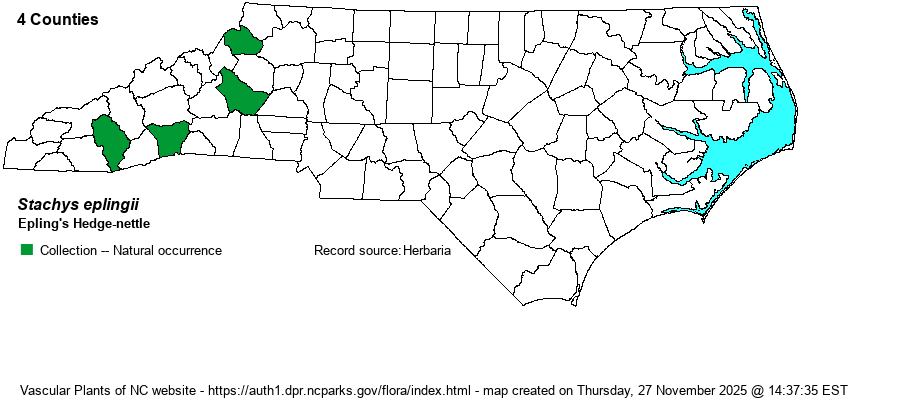| Author | J.B. Nelson | |
| Distribution | A few widely scattered records for the Mountains, not a distinct enough pattern to define a clear range in the province. It was not described until 1979, owing to previous records erroneously being included within S. nuttallii.
This species is a Southern Appalachian endemic, ranging only from western VA and WV and to western SC; recorded only from VA, WV, TN, NC, and SC. | |
| Abundance | Apparently very rare, possibly the rarest of the many Stachys species in the state, though as it is similar to a number of other species, it is probably passed over as other species, especially S. nuttallii, and thus its true abundance might be underestimated. It is State Endangered, with a State Rank of S1. It is Globally Ranked as G1G2 by NatureServe. | |
| Habitat | This is a wetland species, in VA mainly in higher pH soils of wet meadows and calcareous fens. The NCNHP simply says "bogs" for the NC habitat, though a few of the five records in its database might be from other unstated habitats. |
| Phenology | Blooms from June to August, and fruits from August to September. | |
| Identification | This is a species that is quite similar to S. nuttallii; see that species for more description. It differs from it by having the calyx lobes strongly deltoid, versus deltoid-lanceolate in S. nuttallii; and by "stem and abaxial [lower] leaf surface densely atomiferous glandular and with few eglandular hairs" (Weakley 2018), as opposed to "stem and abaxial leaf surfaces moderately glandular and with frequent soft eglandular hairs" in S. nuttallii. Wofford (1989) splits out S. eplingii from S. nuttallii in his key based on length of the petiole; in S. eplingii "Leaves sessile or essentially so, petioles less than 1/4 the length of the longest blades", versus "Leaves with distinct petioles" in S. nuttallii. Thus, a sessile-leaved Stachys found in a bog might be this species, especially if it has a long and slender flower cluster with a drooping tip, might be this species. However, you almost certainly will need to examine hairs on the stem and leaves, as well as the shape of the calyx lobes, to be certain. | |
| Taxonomic Comments | First described in 1979, in response to a distinct species being included within S. nuttallii in herbaria.
Stachys is a large and complex genus that is still actively being worked on, and our understanding of the species is slowly being clarified. For interested readers, we recommend journal papers by Nelson (1981, 2008) and by Fleming et al. (2011). | |
| Other Common Name(s) | None | |
| State Rank | S1 | |
| Global Rank | G1G2 | |
| State Status | E | |
| US Status | | |
| USACE-agcp | FAC link |
| USACE-emp | FAC link |

